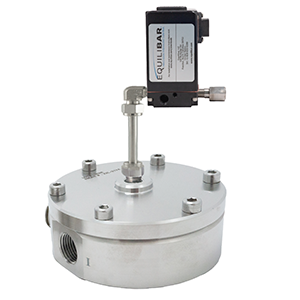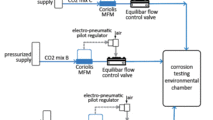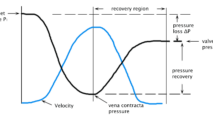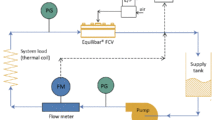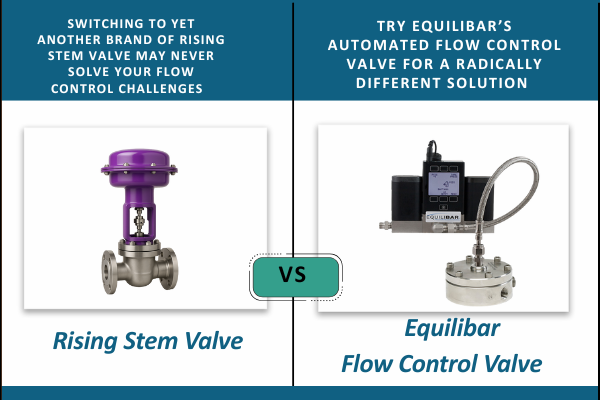In recent years, investment in data centers has seen tremendous growth. The widespread adoption of AI and the move towards more remote work post-pandemic has created a higher demand for various cloud service, web hosting, software, and other services provided via data centers. Cooling infrastructure within these data centers in particular is a rapidly growing market. As of mid 2025, the global market for data center cooling solutions is estimated to be roughly 18 billion USD.
Why are data center cooling systems important?
Data centers have many racks of servers producing heat while they work in the same way your desktop or laptop computer does. Computer components are negatively affected by excess heat; processors will throttle in performance as temperature increases and if the temperature exceeds a certain value, individual components begin to fail. Failed components create unplanned downtime or service outages and require higher capital expenditure over time replacing hardware. Cooling systems are necessary to keep data centers functioning.
At the same time, cooling systems consume massive amounts of energy, often accounting for between 30-50% of a data center’s overall energy consumption. A balance must be struck in designing the most efficient data center cooling system such that component failures are minimized while also minimizing unnecessary power consumption.
What are some common methods of data center cooling?
Data center cooling technologies include using two-phase refrigerants, liquid and air.
Data center cooling with two-phase refrigerant
The most common cooling method using two-phase refrigerants is data center immersion cooling. With immersion cooling the entire data center server rack is immersed in a tank of dielectric liquid refrigerant. The two-phase systems are typically passive, with the liquid refrigerant boiling off, then condensing on water-filled coils before dropping back into the immersion tank. The condenser coils themselves are part of a traditional chilled water system (CWS).
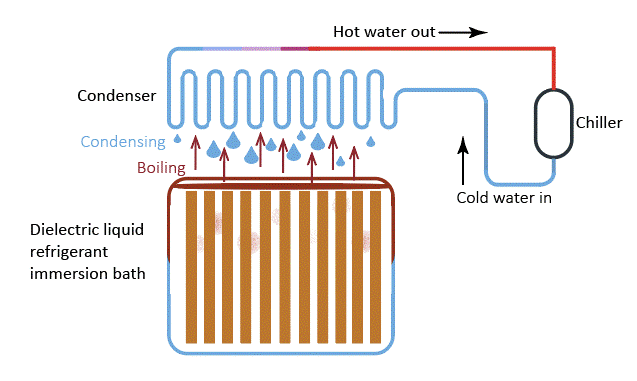
Data center liquid cooling
There are three main methods of data center liquid cooling systems
- Immersion cooling – As with the two-phase cooling setup shown above, liquid immersion systems submerge the entire server within a bath of a dielectric fluid. With a single-phase fluid however, heat must be pulled out of the rack via a coolant distribution unit (CDU) where a pump moves the fluid across a heat exchanger for final heat rejection. That heat can then be managed via traditional means – chilled water loops, evaporative cooling systems, etc.
- Cold plate cooling – In these setups, liquid cooling is circulated by specific components that produce the most heat, typically CPUs/GPUs, via a metal cold plate. Cold water is circulated through the loop where it absorbs heat from these server components, then flows out of the server to a central hot water return for heat rejection. It’s common for these systems to also use fans as well to provide some degree of air cooling for the other components within the server.
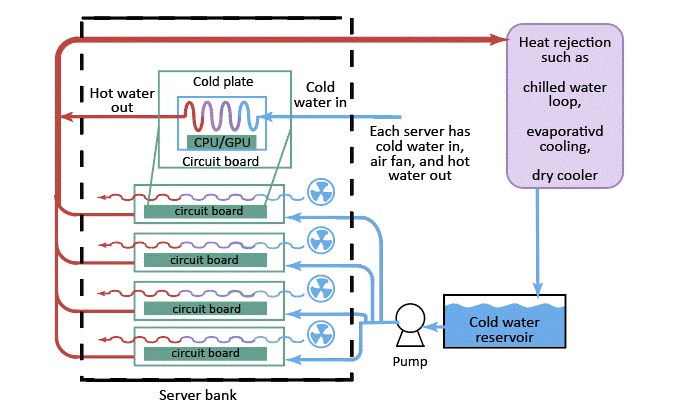 Direct to chip (DTC) is a general term for systems like this where cooling is done at the chip level (as shown above with a plate on the CPU/GPU.)
Direct to chip (DTC) is a general term for systems like this where cooling is done at the chip level (as shown above with a plate on the CPU/GPU.) - Spray cooling – Similar to cold plate DTC cooling, spray cooling is done at a per component level within the rack. A manifold of nozzles within the rack are set up to spray a dielectric liquid at specific components (CPU, GPU, etc). That dielectric fluid drips down into a collection system and is circulated via a small pump through a loop where the heat is transferred out to the building’s water loop via a liquid-to-liquid heat exchanger.
Why choose Equilibar® valves for data center cooling systems?
The unique design of Equilibar back pressure regulators and control valves offer many benefits for a variety of different liquid and two-phase cooling systems.
- Wide operating Cv turndown – Equilibar back pressure and control valves are capable of a minimum 100:1 Cv turndown ratio. In order to accurately maintain the temperature of the coolant, fluid flow and pressure must be precisely controlled. In systems with multiple points-of-use where varying flows are typical (as you would see with in-rack or in-row cooling), there can be a wide variation in the instantaneous flow demand through the main recirculation line. With traditional control valves, the wide flow rate demand may require multiple valves to cover the entire flow range where a single Equilibar valve will suffice.
- Ease of automation – Equilibar valves are dome-loaded with a pilot pressure regulator controlling the setpoint. They can be controlled using an electronic pilot regulator, allowing for easy integration with automated control systems. Equilibar valves can modulate Cv in response to either flow, pressure, or temperature-based feedback.
- Customization for varying service conditions – The simple design of Equilibar valves makes customization with various materials of construction easy for compatibility with liquid and two-phase refrigerants while still retaining the same performance.
- Two-phase refrigerant control – Equilibar valves are uniquely suited for many challenges found within two-phase refrigerant systems. The unique multi-orifice design allows for stable pressure or flow control with mixed-phase liquid gas conditions.
Contact us to discuss your data center cooling system.
Contact an EngineerFrequently Asked Questions (FAQ) about data center cooling
How does air-cooling play a role in data center cooling?
Many of the first data centers relied on air-based cooling architecture – sometimes referred to as computer room air conditioning (CRAC). CRAC systems use a modified air-conditioning system to blow cooled air over servers. Over time, more complex systems with better airflow control were developed with targeted cooling, such as hot and cool aisles on each side of a server rack, to avoid cooling the entire room.
Air-cooled systems work best in lower power systems, typically those requiring cooling capacities of <50 kW. As server densities and power consumption increased, the computing industry began to move away from CRAC towards more efficient two-phase or liquid cooling solutions. Targeted approaches to heat management, in-rack or in-row setups became more common – systems in which the cooling loop is integrated at the level of an individual server rack or row of racks.


